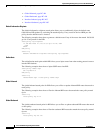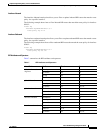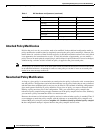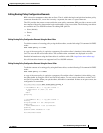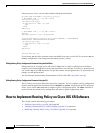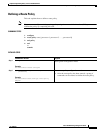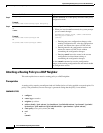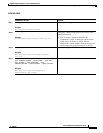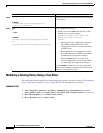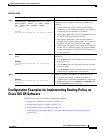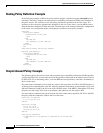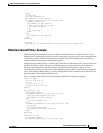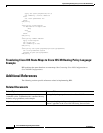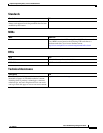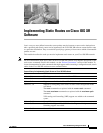
Implementing Routing Policy on Cisco IOS XR Software
How to Implement Routing Policy on Cisco IOS XR Software
RC-412
Cisco IOS XR Routing Configuration Guide
OL-14356-01
Modifying a Routing Policy Using a Text Editor
This task explains how to modify an existing routing policy using a text editor. See the “Editing Routing
Policy Configuration Elements” section on page RC-407 for information on text editors.
SUMMARY STEPS
1. edit {route-policy | prefix-set | as-path-set | community-set | extcommunity-set {rt | soo} |
policy-global | rd-set} name [nano | emacs | vim | inline {add | prepend | remove} set-element]
2. show rpl route-policy [name [detail] | states | brief]
3. show rpl prefix-set [name | states | brief]
Step 5
route-policy policy-name {in | out}
Example:
RP/0/RP0/CPU0:router(config-bgp-nbr-af)#
route-policy example1 in
Attaches the route-policy, which must be well formed
and predefined.
Step 6
end
or
commit
Example:
RP/0/RP0/CPU0:router(config-bgp-nbr-af)# end
or
RP/0/RP0/CPU0:router(config-bgp-nbr-af)# commit
Saves configuration changes.
• When you issue the end command, the system
prompts you to commit changes:
Uncommitted changes found, commit them
before exiting(yes/no/cancel)?
[cancel]:
–
Entering yes saves configuration changes to
the running configuration file, exits the
configuration session, and returns the router
to EXEC mode.
–
Entering no exits the configuration session
and returns the router to EXEC mode without
committing the configuration changes.
–
Entering cancel leaves the router in the
current configuration session without exiting
or committing the configuration changes.
Use the commit command to save the configuration
changes to the running configuration file and remain
within the configuration session.
Command or Action Purpose



